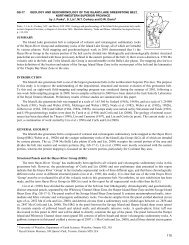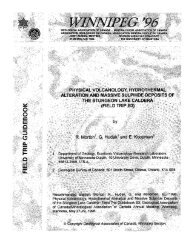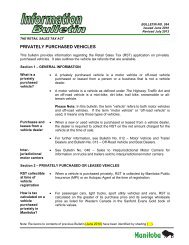Manitoba's Electric Vehicle Road Map - Government of Manitoba
Manitoba's Electric Vehicle Road Map - Government of Manitoba
Manitoba's Electric Vehicle Road Map - Government of Manitoba
You also want an ePaper? Increase the reach of your titles
YUMPU automatically turns print PDFs into web optimized ePapers that Google loves.
<strong>Manitoba</strong>’s<br />
ElEctric vEhiclE<br />
road <strong>Map</strong><br />
Driving toward<br />
Fossil Fuel Freedom<br />
ElEctricity in Motion<br />
Replacing gas vehicles with electric vehicles? Driving cars you plug in<br />
instead <strong>of</strong> gas up? Isn’t this concept too far down the road to think<br />
about? The answer is no.<br />
You may be surprised to know that<br />
<strong>Manitoba</strong> was one <strong>of</strong> the first jurisdictions<br />
in the world to roll out a comprehensive<br />
plug-in hybrid electric vehicle<br />
demonstration. And <strong>Manitoba</strong> is now<br />
well-positioned to take advantage <strong>of</strong><br />
what could be the greatest energy revolution<br />
in 100 years – electricity-powered<br />
transportation. <strong>Manitoba</strong>’s <strong>Electric</strong><br />
<strong>Vehicle</strong> <strong>Road</strong> <strong>Map</strong> puts the province on<br />
the pathway towards this energy and<br />
transportation transformation.<br />
As the new technology unfolds,<br />
<strong>Manitoba</strong> can’t afford to take a back<br />
seat. The new energy revolution <strong>of</strong>fers<br />
the potential to take our number-one<br />
energy weakness – fossil fuel imports,<br />
and replace it with our number-one<br />
energy strength – renewable<br />
hydroelectricity.<br />
Because our situation and conditions<br />
are unique, we must take a measured<br />
approach that is right for <strong>Manitoba</strong>. We<br />
need to gain a specific, local understanding<br />
<strong>of</strong> the technological and economic<br />
impact <strong>of</strong> electric vehicles before<br />
making major, across-the-board investments.<br />
We also need to identify the<br />
best ways to increase the availability,<br />
and accelerate the use <strong>of</strong> these vehicles<br />
in our everyday lives, benefitting both<br />
the economy and our environment.
What’s<br />
in it for<br />
<strong>Manitoba</strong>ns?<br />
thE changing<br />
global EnErgy Equation<br />
Our energy world is changing. Global<br />
demand for energy is expected to<br />
increase by 50 per cent by 2035. Global<br />
demand for cars and other vehicles is<br />
also increasing. Easy-to-reach, inexpensive<br />
petroleum, which the world<br />
depends on to operate its vehicles, is<br />
dwindling, while new supplies come<br />
from sources more and more difficult to<br />
access. The result – higher oil prices. Today’s<br />
geopolitical uncertainty in different<br />
parts <strong>of</strong> the world is also causing upward<br />
<strong>Electric</strong> transportation — the potential benefits to <strong>Manitoba</strong>ns over the<br />
coming decades:<br />
• <strong>Manitoba</strong> would have the least expensive vehicle fuel (electricity) on the continent<br />
— estimated at 6¢ to 20¢ per litre, gasoline equivalent.<br />
• Each year, thousands <strong>of</strong> dollars in savings could go back in the pockets <strong>of</strong> average<br />
<strong>Manitoba</strong>n families.<br />
• <strong>Manitoba</strong>’s economy, as a whole, could save more than $1 billion that’s going out<br />
<strong>of</strong> province — money which could be spent at home, creating jobs and generating<br />
new business.<br />
• Since <strong>Manitoba</strong>’s electricity is almost completely greenhouse gas (GHG)-free,<br />
switching from a fossil fuel like gasoline to electricity would create large-scale<br />
GHG reductions.<br />
pressure on oil prices. Rising oil prices<br />
do not only affect individual <strong>Manitoba</strong>ns<br />
and their families, but also, the growth<br />
prospects <strong>of</strong> our economy as a whole.<br />
Fossil fuels are not just an economic<br />
problem. Their domination <strong>of</strong> the world’s<br />
energy continues to cause serious environmental<br />
problems worldwide. Climate<br />
change, a by-product <strong>of</strong> GHG emissions,<br />
continues to threaten and disrupt our<br />
natural world, and possibly, even our<br />
The changing energy equation has<br />
increased the need for more efficient<br />
and cleaner forms <strong>of</strong> transportation.<br />
Automakers around the world have<br />
embraced this demand and are developing<br />
many models <strong>of</strong> electric and plug-in<br />
hybrid electric vehicles. They are also<br />
improving conventional vehicle fuel-<br />
own existence. Every day, the smog in<br />
the air is harming our health and our<br />
cities. Oil, gas and other toxic chemical<br />
spills are poisoning our water, our<br />
wildlife and our citizens. These are not<br />
small problems.<br />
thE shift to clEanEr transporation has bEgun<br />
New Flyer Industries sets the standard with its Xcelsior hybrid bus.<br />
Photo courtesy <strong>of</strong> New Flyer Industries<br />
This connector for the charger cord makes filling up<br />
your car is as simple as plugging it in.<br />
Photo courtesy <strong>of</strong> Mitsubishi Motors Canada<br />
efficiency and expanding the capacity to<br />
use higher blends <strong>of</strong> bi<strong>of</strong>uels.<br />
But the demand for cleaner transportation<br />
extends beyond the automobile.<br />
The race is also on to produce electric<br />
drive buses, and use advanced battery<br />
systems to provide auxiliary power for<br />
heavy-duty vehicles.
thE nuMbErs gaME:<br />
hoW <strong>Manitoba</strong> stacks up<br />
There are currently more than 700,000<br />
motorized vehicles operating in<br />
<strong>Manitoba</strong>. All but a select few require<br />
fossil fuels (gasoline or diesel) to<br />
operate. <strong>Manitoba</strong>ns use about 1.5<br />
billion litres <strong>of</strong> gasoline and one billion<br />
litres <strong>of</strong> diesel fuel annually.<br />
Our overall fuel consumption per vehicle<br />
is also fairly high. For example, the<br />
average gasoline-powered vehicle uses<br />
around 15 litres per one-hundred<br />
kilometres. This high fuel consumption<br />
is due, in part, to <strong>Manitoba</strong>’s cold winter<br />
conditions. As well, a great many light<br />
trucks and SUVs are purchased by<br />
<strong>Manitoba</strong>ns, particularly in urban areas.<br />
<strong>Manitoba</strong>’s<br />
ElEctrifying<br />
advantagEs<br />
It only makes sense for <strong>Manitoba</strong>ns to<br />
use electric and plug-in hybrid electric<br />
vehicles to the greatest extent possible.<br />
We have “green” fuel<br />
<strong>Manitoba</strong> Hydro is well-recognized<br />
for having the highest proportion <strong>of</strong><br />
renewable electricity generation (98 per<br />
cent-plus) in its grid-mix in all <strong>of</strong> North<br />
America. With new hydroelectric and<br />
wind projects, we can even surpass that.<br />
<strong>Manitoba</strong> drivers will not only save<br />
money by refueling with electricity, they<br />
will also make deep, sustainable cuts in<br />
the associated emissions. If all 10 billion<br />
vehicle-kilometres now travelled in<br />
<strong>Manitoba</strong> using gasoline, were electrically<br />
powered, it would require somewhere<br />
in the range <strong>of</strong> a 300 to 700 MW wind<br />
farm. And it would result in 3 to 4 million<br />
tonnes <strong>of</strong> GHG emission reductions.<br />
We have the right price<br />
<strong>Manitoba</strong> has among the lowest electricity<br />
rates in North America. This means<br />
that for electric and plug-in hybrid electric<br />
vehicles, we have the lowest priced elec-<br />
<strong>Manitoba</strong> does produce some crude<br />
oil, but quantities are limited, and it’s<br />
exported for further processing. The<br />
key fact is, all refined gasoline and diesel<br />
bought at the pump is imported into<br />
<strong>Manitoba</strong>, so the payment for these fuels<br />
flows out <strong>of</strong> province.<br />
Paying for our reliance on fossil fuel has<br />
become <strong>Manitoba</strong>’s number-one energy<br />
weakness. By the mid-1990s, the money<br />
leaving <strong>Manitoba</strong> to pay for all imported<br />
fossil fuels was about $1 billion<br />
annually. In 2011, this amount has more<br />
than doubled – it’s in the range <strong>of</strong> $2 to<br />
$3 billion annually.<br />
tric fuel on the continent. We could easily<br />
convert one <strong>of</strong> our greatest energy weaknesses<br />
(imported fossil fuels) to one <strong>of</strong><br />
our greatest strengths (hydroelectricity).<br />
The cost to “fill ‘er up” with electricity<br />
has been estimated in the range <strong>of</strong> 6¢ to<br />
20¢ per litre, gasoline equivalent. (Note:<br />
Gasoline-equivalent costs also depend<br />
on the vehicle.) As well, electricity prices<br />
are stable and predictable – the price<br />
doesn’t spike because it’s a long weekend,<br />
or summer, or because <strong>of</strong> events in<br />
the Middle East.<br />
We have the infrastructure<br />
<strong>Manitoba</strong> has more than half-a-million<br />
plug-in points in our homes, garages,<br />
businesses and parking lots. These are<br />
already used for block heaters and<br />
preheating vehicles. They can easily be<br />
used for electric vehicle recharging.<br />
That existing infrastructure accommo-<br />
That money is lost to <strong>Manitoba</strong>’s<br />
economy. As the costs <strong>of</strong> fossil fuels<br />
increases, those losses will continue to<br />
grow. Every 20-cent increase at the pump<br />
equates to roughly $500 million more<br />
leaking from the <strong>Manitoba</strong> economy. This<br />
is enough to pay the entire annual<br />
electricity bill <strong>of</strong> every <strong>Manitoba</strong> family.<br />
The fossil fuel used for transportation is<br />
also one <strong>of</strong> the largest sources <strong>of</strong> GHG<br />
emissions in <strong>Manitoba</strong> – more than<br />
seven million tonnes. Transportation<br />
represents more than one-third <strong>of</strong> all the<br />
<strong>Manitoba</strong> GHG emissions.<br />
Westward Industries’ made-in-<strong>Manitoba</strong> hybrid Go4 Interceptor III.<br />
Photo courtesy <strong>of</strong> Westward Industries<br />
dates what’s referred to as “Level 1”<br />
charging. While slower than higher voltage<br />
“Level 2” charging systems, “Level<br />
1” can be a practical solution in the near<br />
term for electric and plug-in electric<br />
vehicles used primarily for commuting<br />
shorter distances.<br />
For other jurisdictions to put in place<br />
500,000 recharging systems would cost<br />
them over $1 billion. <strong>Manitoba</strong> has this<br />
recharging infrastructure already in place<br />
today, <strong>of</strong>fering a significant advantage<br />
and substantial investment savings.<br />
We know how to “plug in”<br />
<strong>Manitoba</strong> also has a well-established<br />
plug-in culture for vehicles – it’s called<br />
winter. We don’t need special training<br />
courses to teach people how to plug in<br />
their vehicles. We’ve been doing it since<br />
we learned to drive.
<strong>Manitoba</strong>’s<br />
ElEctric vEhiclE road <strong>Map</strong>:<br />
shifting into drivE<br />
What we know:<br />
• the scale <strong>of</strong> the opportunity before<br />
<strong>Manitoba</strong> is clear<br />
• <strong>Manitoba</strong> has many assets to speed<br />
the transition from fossil fuel to clean,<br />
renewable transportation energy<br />
• this transition will not happen<br />
overnight<br />
• we can’t control the pace at which<br />
electric vehicles are made available in<br />
the marketplace<br />
What we can do:<br />
• focus on maximizing our advantages<br />
• create the relationships and environment<br />
necessary to fast track electric<br />
vehicles into <strong>Manitoba</strong> as they<br />
become available<br />
• make the transition as swift, cost-effective<br />
and comprehensive as possible<br />
As this energy revolution begins to<br />
unfold, <strong>Manitoba</strong>’s early actions on the<br />
road to electric vehicles will include:<br />
1. plug-in partnerships<br />
<strong>Manitoba</strong> will facilitate partnerships<br />
with automakers, electric technology<br />
providers, <strong>Manitoba</strong> Hydro, <strong>Manitoba</strong><br />
companies, academic institutions and<br />
others to:<br />
fossil fuEl frEEdoM<br />
While it’s unlikely that one method for<br />
powering vehicles will monopolize the<br />
future, the road signs point to the rapid<br />
expansion <strong>of</strong> electric transportation as<br />
a cleaner and more affordable path.<br />
<strong>Manitoba</strong> stands to reap an enormous<br />
harvest as progress is made.<br />
Here are two simple ways to quantify the<br />
value <strong>of</strong> making this transition swiftly and<br />
comprehensively:<br />
• Each <strong>Manitoba</strong> family shifting to<br />
electric vehicles is on the path towards<br />
$100,000 in economic benefit -- for<br />
themselves and <strong>Manitoba</strong>.<br />
April 2011<br />
• demonstrate vehicles under real-world<br />
conditions, and to better understand<br />
how they perform in <strong>Manitoba</strong>’s<br />
unique climatic conditions (ex: coldweather<br />
performance)<br />
• help speed up adoption by ensuring<br />
widespread availability <strong>of</strong> vehicles and<br />
recharging equipment<br />
• promote <strong>Manitoba</strong>’s advantages as<br />
a location for business development,<br />
including opportunities in the<br />
development, testing and, potentially,<br />
manufacturing <strong>of</strong> electric vehicle<br />
technologies<br />
• raise public awareness <strong>of</strong> electric<br />
vehicle technologies<br />
2. <strong>Electric</strong> vehicle advisory<br />
committee<br />
An advisory committee will be created<br />
to provide recommendations<br />
to government on the best ways to<br />
prepare for, and speed adoption <strong>of</strong>,<br />
electric and hybrid-vehicles. Areas to<br />
be addressed include:<br />
• maximizing out-<strong>of</strong>-the-gate use <strong>of</strong><br />
<strong>Manitoba</strong>’s existing $1 billion recharging<br />
infrastructure<br />
• identifying recharging infrastructure<br />
requirements beyond our extensive<br />
existing system (ex: the need for localized,<br />
faster charging infrastructure)<br />
• Every one per cent share <strong>of</strong> the<br />
<strong>Manitoba</strong> vehicle market that moves<br />
to electric vehicles equates to $10<br />
million injected back to the provincial<br />
economy, and 30,000 tonnes in GHG<br />
emission reductions.<br />
And freedom from fossil fuels? While<br />
electric vehicles are only part <strong>of</strong> that<br />
larger equation, the next year could<br />
see <strong>Manitoba</strong>’s first families becoming<br />
virtually fossil fuel free – utilizing clean,<br />
renewable hydro for their electricity<br />
needs; heat pumps for home heating;<br />
and driving an emission-free electrical<br />
vehicle powered by our hydroelectricity.<br />
Fossil Fuel Freedom, perhaps closer<br />
than we think.<br />
• large-scale integration <strong>of</strong> electric<br />
vehicle charging into the electrical grid<br />
• consideration <strong>of</strong> upfront fiscal support<br />
mechanisms and/or innovative<br />
financing mechanisms for car, battery<br />
and recharging infrastructure<br />
• vehicle insurance implications<br />
• public outreach<br />
• cold weather performance and<br />
adaptation<br />
• battery life and secondary use or<br />
battery repurposing<br />
• training and education requirements<br />
for vehicle servicing<br />
• building code implications for<br />
recharging equipment<br />
• electric vehicle codes, standards<br />
and regulations<br />
3. Electic vehicle learning and<br />
demonstration centre<br />
A centre will be created to help<br />
demonstrate various electric and<br />
plug-in electric vehicles and associated<br />
recharging equipment that will<br />
soon be commercially available to<br />
<strong>Manitoba</strong>ns. Not only will performance<br />
<strong>of</strong> the vehicles be monitored, but the<br />
public will have a first-hand opportunity<br />
to learn more about this transitional<br />
technology before they decide to buy.<br />
This information provided by:<br />
<strong>Manitoba</strong> Innovation, Energy and Mines<br />
Energy Development Initiative<br />
www.manitobaenergy.ca
<strong>Manitoba</strong> <strong>Vehicle</strong> Facts<br />
• 700,000 vehicles (all types) currently in <strong>Manitoba</strong><br />
• 40,000 to 50,000 new vehicles sold annually<br />
• over 1,600 hybrid electric vehicles (HEV)<br />
licensed in <strong>Manitoba</strong> since 2006<br />
• about 1.5 billion Litres <strong>of</strong> gasoline and 1.0 billion<br />
Litres <strong>of</strong> diesel fuel used annually in <strong>Manitoba</strong><br />
• average gasoline fuel consumption<br />
> 15 Litres per 100 km in <strong>Manitoba</strong><br />
> 12.5 Litres per 100 km rough average<br />
for all <strong>of</strong> Canada<br />
• transportation represents more than one third<br />
<strong>of</strong> <strong>Manitoba</strong>’s GHG emissions<br />
• average <strong>Manitoba</strong> vehicle travels about 16,000<br />
km per year, or about 43 km per day<br />
• currently between 15 to 25 all-electric and<br />
plug-in hybrid electric (PHE) vehicles in<br />
<strong>Manitoba</strong>, with the numbers quickly rising<br />
World <strong>Vehicle</strong>/Energy Facts<br />
• world demand for automobiles is roughly 60<br />
million vehicles annually<br />
• by 2035, world energy demand will be more<br />
than 50 per cent higher than 2007<br />
• price <strong>of</strong> oil has been rebounding from a low<br />
<strong>of</strong> around $40 per barrel in early 2009 back to<br />
roughly $110 per barrel in April 2011<br />
Commercial Release <strong>of</strong> <strong>Electric</strong><br />
<strong>Vehicle</strong>s: 2011 to 2016<br />
• factory-built models such as the Mitsubishi<br />
IMiEV, Nissan Leaf and Chevrolet Volt just<br />
being commercially released<br />
• initial electric vehicle prices $30,000 to $45,000<br />
• prices will fall as more vehicles become available<br />
• thirty models <strong>of</strong> all-electric and PHEV under<br />
development for potential release within five years<br />
• all major vehicle manufacturers involved<br />
Recharging Systems<br />
Recharging time depends on charge required<br />
and level <strong>of</strong> charging. Estimated time required<br />
to charge a 8 kWh battery:<br />
• Level 1 charge (110 VAC, 15 A) about 8 hours<br />
(or overnight)<br />
• Level 2 charge (220 VAC, 40 A) about 3 to 4 hours<br />
• Level 3 charge (high voltage DC charge) about<br />
15 to 30 minutes<br />
<strong>Manitoba</strong>’s Recharging Infrastructure<br />
• <strong>Manitoba</strong> already has more than 500,000<br />
plug-points at homes, businesses and parking<br />
lots that could be used for Level 1 charging <strong>of</strong><br />
electric vehicles<br />
• for another jurisdiction to build this infrastructure<br />
today from scratch would cost upwards <strong>of</strong><br />
$1 billion<br />
Cost <strong>of</strong> Recharging Systems<br />
• Level 1 charging can be done almost anywhere<br />
with access to a regular electrical outlet.<br />
No additional cost.<br />
• Installing a home-based Level 2 charger depends<br />
on wiring services available, but is in the range<br />
<strong>of</strong> $2,000 to $4,000.<br />
• A commercial or “public pay” Level 2 charging<br />
station is more costly.<br />
• A Level 3 charging system is very expensive,<br />
currently averaging more than $30,000 per<br />
charging point.<br />
<strong>Electric</strong>al Load for <strong>Vehicle</strong>s<br />
• <strong>Manitoba</strong> Hydro estimates that by 2030 the<br />
load for electric vehicles could reach 195 GWh,<br />
with this considered as a relatively modest<br />
load. This compares to total annual generation<br />
<strong>of</strong> roughly 23,000 GWh and extra-provincial<br />
exports <strong>of</strong> about 10,000 GWh.<br />
• Assuming all gasoline vehicles in <strong>Manitoba</strong><br />
were converted to electricity, we would<br />
require 1,200 GWh to 2,500 GWh annually,<br />
(depending on vehicles size and efficiency).<br />
• As a new load, this would require new wind<br />
farms ranging from 300 MW to 700 MW.

















